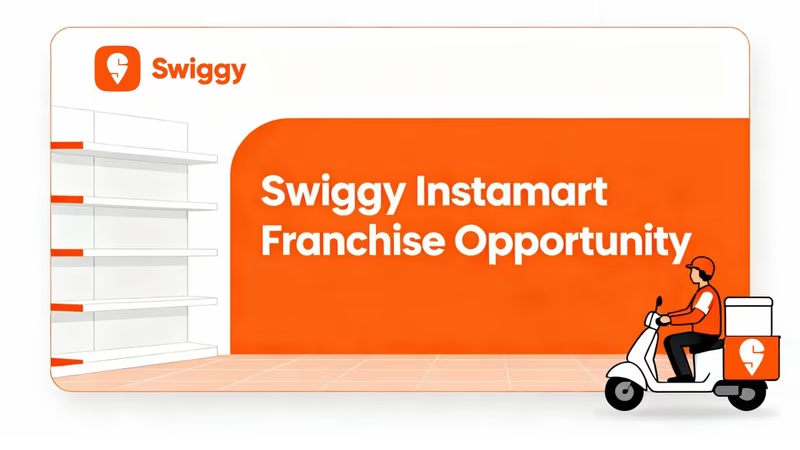Swiggy, founded in Bengaluru in 2014 by Sriharsha Majety, Nandan Reddy, and Rahul Jaimini, is India’s leading food delivery platform.
In 2020, Swiggy expanded into quick commerce by launching Swiggy Instamart, a 10–30 minute delivery service that uses local “dark stores” to stock and deliver essentials.
Today, Swiggy Instamart operates in 30+ cities with hundreds of partner-operated stores, selling everything from fresh produce to snacks and ice cream.
Quick commerce has become a lifestyle trend. Studies even show that 1 in 10 ice cream orders in India now comes through online apps like Instamart, proving that people love instant convenience.
This surge in demand makes Instamart a great business opportunity for aspiring entrepreneurs.
Partnership Models with Swiggy Instamart
Swiggy makes it easy for entrepreneurs to join the quick-commerce revolution. There are three ways you can partner with Instamart:
- Dark Store Partner
You provide the store space, manage staff, stock inventory, and handle day-to-day operations. Swiggy takes care of orders, technology, and deliveries. This is the most popular model for entrepreneurs.
- Vendor/Seller Partner
If you’re a manufacturer, wholesaler, or distributor, you can supply products directly to Swiggy’s dark stores. This is perfect for FMCG distributors looking for consistent bulk orders.
- Logistics Partner
If you have experience in managing delivery fleets, you can handle last-mile delivery operations for Swiggy Instamart.
Most small business owners opt for the Dark Store Partner model because it gives them full control over operations and the chance to earn margins on every order.
Technology Advantage
Swiggy Instamart isn’t just about stocking products – it’s powered by cutting-edge technology that helps partners maximize profits:
- AI-Powered Demand Forecasting – Predicts what products will sell more in your area so you can avoid overstocking.
- Real-Time Inventory Management – Tracks every SKU and alerts you when stock is low.
- Automated Reordering System – Ensures you never run out of high-demand products like milk or ice cream.
- Partner Dashboard & Analytics – Gives you data on daily sales, margins, and top-selling items.
- Customer Insights – Understand buying patterns and adjust your stock accordingly.
Technology reduces waste, improves efficiency, and helps you focus on growth instead of manual operations.
Investment & Setup Costs
To open a Swiggy Instamart partner store, you’ll need to invest in space, furniture, equipment, inventory, and staff. Here’s a detailed breakdown:
| Expense Category | Estimated Cost (Metro Cities) | Estimated Cost (Tier-2 Cities) |
| Furniture & Interiors (shelves, branding, lighting) | ₹6–8 Lakhs | ₹4–5 Lakhs |
| Equipment (freezers, cabinets, POS systems) | ₹3–4 Lakhs | ₹2–3 Lakhs |
| Initial Inventory | ₹8–10 Lakhs | ₹6–7 Lakhs |
| Rent (monthly) | ₹2–3 Lakhs | ₹1–1.5 Lakhs |
| Working Capital (2-3 months) | ₹3–4 Lakhs | ₹2–3 Lakhs |
| Staff Salaries & Training | ₹2–3 Lakhs | ₹1.5–2 Lakhs |
| Total Investment | ₹20–30 Lakhs | ₹12–18 Lakhs |
Tip: Choose a location with high residential density and easy road access for delivery partners to maximize orders and ROI.
Want to cash in on India’s 10-minute delivery boom? Read our Blinkit Franchise Guide and discover how you can turn quick commerce into quick profits!
Products and Services (What You Sell)
Your Instamart store will stock fast-moving consumer goods (FMCG) and daily essentials. Here’s what’s usually sold:
| Category | Examples |
| Fresh & Frozen | Milk, Eggs, Vegetables, Ice Cream, Frozen Snacks |
| Groceries | Rice, Atta, Pulses, Spices, Oils, Tea, Coffee |
| Snacks & Beverages | Chips, Biscuits, Noodles, Soft Drinks, Juices |
| Daily Necessities | Bread, Breakfast Cereals, Packaged Food |
| Personal Care | Soap, Shampoo, Toothpaste, Sanitary Products |
| Household | Cleaning Liquids, Detergents, Utensil Cleaners |
| Baby & Pet | Diapers, Baby Food, Pet Food |
Stock more of the fast-moving SKUs (snacks, beverages, and ice cream) as they generate higher sales volume and profits.
Profitability & ROI
Swiggy Instamart offers a promising business model with healthy margins if managed well.
| Metric | Details |
| Monthly Revenue Potential | ₹8–12 Lakhs (Metro) |
| Net Profit Margin | 10–15% per month |
| Average Monthly Profit | ₹40,000 – ₹1.5 Lakhs |
| Break-even/ROI Period | 6–12 Months (Metro) |
| Commission from Swiggy | 85–90% of Order Value |
Key Insight: The faster your order volume grows, the quicker you reach profitability. Stock fast-moving items, manage inventory carefully to avoid spoilage, and keep rent under control.
Dreaming of running your own e-commerce business? Dive into our Flipkart Franchise 2025 Guide to uncover costs, profit margins, and how to get started today!
Eligibility & Requirements
- Space: 800–1200 sq ft in a high-demand residential/commercial area.
- Investment: Minimum ₹12 to 15 Lakhs in working capital.
- Experience: Retail/FMCG experience preferred but not mandatory.
- Licenses Required: GSTIN, FSSAI License (for food items), Shop/Trade License.
- Documents Required:
- PAN & Aadhaar of Owner
- Rental Agreement / Property Proof
- GST Certificate
- Bank Details (Cancelled Cheque)
- Inventory/SKU List
- PAN & Aadhaar of Owner
Step-by-Step Application Process
Follow these steps to apply for a Swiggy Instamart partner store:
- Visit Swiggy Partner Portal → Go to Swiggy’s official partner page.
- Submit Application Form → Fill in store location, investment capacity, and personal/business details.
- Upload Documents → PAN, Aadhaar, GST, FSSAI license, property proof, and bank details.
- Site Verification → Swiggy team visits and inspects your proposed store location.
- Sign Agreement → Once approved, sign the partnership agreement.
- Set Up Your Store → Install shelves, freezers, branding, and stock your initial inventory.
- Training & Onboarding → Learn to use Swiggy’s partner app and inventory tools.
- Go Live → Your store is listed on Swiggy Instamart and starts receiving orders.
Advantages & Risks
Advantages:
- Zero delivery management - Swiggy handles logistics.
- Strong brand recognition and existing customer base.
- No royalty fee (only order commission is charged).
Risks:
- High rent in metro cities can affect profits.
- Inventory spoilage for perishables.
- Competition from Blinkit, Zepto, and local stores.
Explore the Yewale Amruttulya Franchise Guide – discover cost, profit, and ROI to start your chai business journey today.
A Swiggy Instamart franchise (partner store) can be a profitable venture for entrepreneurs with the right location, investment, and management skills.
With 10–15% net profit margins, a well-run store can break even within 6–12 months and generate steady monthly income.
By stocking fast-moving products, keeping operations lean, and leveraging Swiggy’s platform, you can build a strong, sustainable business.
Turn small savings into golden rewards! Start saving in digital gold with the Jar app.
Additional Benefits of Becoming a Swiggy Partner
Becoming a Swiggy partner offers more than just onboarding support.
You also get access to real-time sales insights, local demand trends, and marketing boosts through app visibility.
Swiggy’s partner dashboard helps you track orders, revenue, cancellations, and customer behaviour so you can improve performance.
You can also use combo deals, high-margin product placements, and quick restocking to increase daily sales. Overall, partnering with Swiggy gives store owners a structured, data-driven way to grow faster with lower marketing effort.
FAQs
1. How much is Swiggy Instamart's franchise?
There is no fixed franchise fee. You mainly invest in store setup, inventory, and operations (₹12–30 Lakhs depending on city).
2. How to franchise Swiggy Instamart?
Apply through the Swiggy Partner Page, submit documents, complete site verification, and sign the agreement.
3. How do I open Instamart?
Get a suitable location (800–1200 sq. ft.), arrange investment, apply online, and complete onboarding.
4. Is Instamart in profit or loss?
Swiggy Instamart as a business is growing rapidly and expected to be profitable in the coming years. Many individual partner stores break even in 6–12 months.
5. How much commission does Swiggy Instamart take?
Swiggy retains around 10–15% commission per order; partners get 85–90% of the order value.
6. Which is better, Instamart or Blinkit?
Instamart has wider reach and is backed by Swiggy’s strong food delivery network, while Blinkit focuses purely on groceries. Choice depends on your local market demand.










